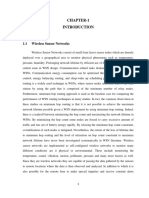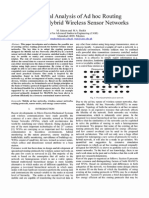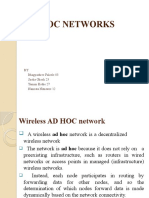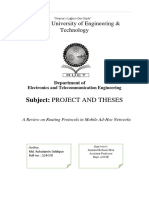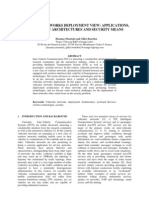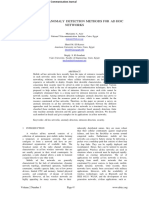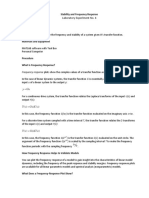Ubicc Dwmsn-Ems 466
Ubicc Dwmsn-Ems 466
Copyright:
Available Formats
Ubicc Dwmsn-Ems 466
Ubicc Dwmsn-Ems 466
Original Description:
Original Title
Copyright
Available Formats
Share this document
Did you find this document useful?
Is this content inappropriate?
Copyright:
Available Formats
Ubicc Dwmsn-Ems 466
Ubicc Dwmsn-Ems 466
Copyright:
Available Formats
Ubiquitous Computing and Communication Journal
DISTRIBUTED WIRELESS MOBILE SENSOR NETWORK MODEL
AND EFFICIENT ROUTING ADOPTED TO DYNAMIC CHANGE OF
TOPOLOGY
Prof. P. Kalyani, Dr.C.Chellappan
Department of CSE, I.R.T.T., Erode, India.
Email: kalyani_irtt@yahoo.co.in
ABSTRACT
Integration of heterogeneous wireless networks poses challenges and limitations in
building multiple interfaces and corresponding bridges/ gateways functionalities.
Integration of heterogeneous wireless networks enables the information exchange
across multiple wireless networks which are difficult now. We propose a wireless
mobile sensor network in a distributed environment is a new architectural model
that merges the advantages of wireless mesh networks, cellular networks, and
wireless sensor networks and the data from Wireless Sensor Networks send to
Internet through the Cellular Network. Integration of the sensor network which
ride on cellular networks taking the advantages of GPS technology in collecting
enormous data about environment like temperature, humidity, air pollution level
etc. at low-cost. This rich, up-to-date, data collection helps researches to take
dynamic decision and passing the same to the people instantaneously. In this paper
we propose a scalable architecture DWMSN and analyze key research issues in
routing adapted to mobility of both sink and node. A new method is proposed for
an efficient protocol adopting the dynamic change of topology due to strong
mobility. Further a prototype design is proposed for environmental monitoring
and surveillance (EMS) applications under DWMSN architectural model.
Keywords: Wireless Mobile Sensor Networks, DWMSN, Environmental sensors,
environmental monitoring system, EMS.
1. RELATED WORK
Recent advances in wireless sensor have led to
many new protocols specifically designed for sensor
networks where energy awareness is an essential
consideration. Most of the attention however has
been given to the routing protocols since they might
differ depending on the applications and network
architecture.[4,7] Sensor nodes are constrained in
energy supply and bandwidth. Such constraints
combined with a typical deployment of large number
of sensor nodes have posed many challenges to the
design and management of sensor networks. These
challenges necessitate energy awareness at all layers
of networking protocol stack. The issues related to
physical and link layers are generally common for all
kind of sensor applications, therefore the research on
these areas has been focuses on energy aware MAC
protocols.[3,10,11] At the network layers, the main
aim is to find ways for energy efficient route setup
and reliable relaying of data from the sensor nodes to
the sink so that the life time of the network is
maximized. The application of wireless sensor
networks in a distributed environment [6] is to create
awareness to the people about the environmental
factors and providing reliable information and then
Volume 5 Number 2
Page 33
enabling for intelligent decision making.
1.1 Wireless Sensor Network (WSN)
The flexibility, fault tolerance, high sensing, self
organization, fidelity, low-cost and rapid deployment
characteristics of sensor networks are ideal to many
new and exciting applications areas such as military,
environment monitoring, intelligent control, traffic
management, medical treatment, manufacture
industry and so on[8].The existing protocols for
WSNs are built on the network architecture (ie) flat
architecture
such that all sensor nodes are
homogeneous and send their data to a single sink
node by multiple hops [9] Such a flat architecture is
inapplicable to many real applications with largescale, heterogeneous sensor nodes, the flat
architectural model inherently has the following
problems.
1.
2.
3.
Unbalance energy consumption among
modes.
Poor scalability and Poor robustness
Single point of failure causes total failure.
www.ubicc.org
Ubiquitous Computing and Communication Journal
Owing to above limitations of traditional
architecture of WSNs, Distributed wireless mobile
sensor networks-DWMSNs is designed to improve
scalability, reliability and throughput of sensor
network and to support mobility of both sink and
nodes. The characteristics of routing in sensor
network that makes it different from that of
traditional communication and wireless ad_hoc
network. To deal with the specific characteristics of
sensor nodes along with the application and
topology, many routing mechanisms have been
proposed. [1,4] Almost all of them can be classified
as data centric, hierarchical or location based
although there are few distinct based on network
flow or QoS awareness.
1.2
Wireless Mesh Network (WMN)
WMN is a kind of new wireless network
architecture paid more and more attention recently.
[2,12] WMNs is a self organized, self configured and
decentralized wireless network. There are two kinds
of nodes in WMN: 1. Mesh router. 2. Mobile client.
Mesh routers with powerful capacities and lower
mobility are automatically setup and maintain
wireless connection forming the backbone of
WMNs. One of the most significant characteristics of
WMNs is that it provides interconnections among all
networked nodes, where each node can send and
receive data directly to each other. WMNs are able to
automatically discover topology change and self
adaptively modify routing for more efficient data
transmission. Moreover WMNs are teach to achieve
load balance by routing parts of data to gateway
nodes with lower load. The proposed issue of
network integration of wireless sensor networks
with WMNs(fig.1.) highlighted and connected to
internet through the gateway .
Volume 5 Number 2
Page 34
1.3 Network Integration
By deploying some super mesh nodes as
gateway node with capacities to transmit data in a
long-distance way and self-organize reliably,
DWMSN merges the advantages of WMN mesh
networks and WSN. It provides the capacities to
interconnect
multiple
homogeneous
and
heterogeneous sensor networks, and to improve
scalability, robustness and data throughput of sensor
networks and support the mobility of nodes (both
sink and node) there by adaptive to dynamically
changing environment and topology.
2
PROBLEM DEFINITION And ISSUES
Routing is highly related to network architecture.
Also for DWMSN there has not yet a well defined
architectural model with scalability, robustness. Also,
there is a lack of efficient
routing protocols for
DWMSN considering multiple mobile sink nodes
adapting to mobility. This paper addresses the above
challenging issues focusing on these parts:
1).
The proposed protocols supports
mobility adoption for dynamically changing
topology due to strong mobility of nodes
and needs synchronization of nodes.
2.)
Efficient
routing
protocols
adopting
mobility
and
aiming
at
maximizing the lifetime of the sensor
networks.
3.)
Design of a prototype to WSN
architectural model for environmental
monitoring
www.ubicc.org
Ubiquitous Computing and Communication Journal
3.
3. PROPOSED ARCHITECTURE
DWMSN supports mobility of sensor nodes and
each sensor networks includes
more than one
Wireless Gateway Nodes (sink). This model can
easily connect
multiple homogeneous (or)
heterogeneous sensor networks. The Gateways and
routers deployed in different sensor networks
automatically interconnect to form a mesh network
while are connected with internet through power full
base station. The Advantages of WMNs are applied
to mobile sensor network and a new architecture is
proposed DWMSN as shown in Fig 2.
4.
They support multihop routing. This means
that data from a node can jump through
multiple nodes before delivering its
information to a host gateway (or)
controller that may be monitoring the
network.
They support mobility of both sink and
node there by adapting the dynamic change
of topology.
4. EFFICIENT ROUTING PROTOCOL FOR
WMSN
Most of the routing protocols [4] for sensor
networks require location information for sensor
network. The location information needed in order to
calculate the distance between two nodes since there
is no addressing scheme for sensors networks like IP
addresses and they are spatially deployed on a
region location information can be utilized in routing
data in an energy efficient way. [13,14] For example
of the region to be sensed is known using location of
sensors, the query can be diffused only to that
particular region which will eliminate the number of
transmission significantly.
In traditional architecture of sensor networks
with a single sink, sensor nodes around the sink (Fig.
3.a) inevitably drain their energy ahead of other
nodes because of more heavy data forwarding,
whether using flat, hierarchical or other routing.
There are three logical layers.
1. Lower layer wireless sensor networks for
monitoring
and
reporting
objects:
information (eg. Temperature, humidity)
2.
Middle layer wireless mesh network for
transmitting sensed data in long distance
and reliable way.
3. Upper layer Internet for users to remotely
access sensed data.
State of the art DWMSN often has some of the
following characteristics.
1.
2.
They are self-forming. As nodes are
powered on, they automatically enter the
network.
They are self-healing. As a node leaves the
network the remaining nodes automatically
re-routed their signals around the out-ofnetwork. Node to ensure a more reliable
communication path.
Volume 5 Number 2
Page 35
The issues taken in this paper for routing
protocols is the consideration of nodes mobility.
Almost all the current protocols assume that the
sensor nodes and the sink are stationary. However,
there might be situation such as battle environment
where the sink and the sensors need to be mobile. In
such case, the frequent update of the position of the
command node and the sensor nodes and the
propagation of that information safely through the
www.ubicc.org
Ubiquitous Computing and Communication Journal
wireless network may excessively drain the energy
of nodes. New routing algorithms are needed in order
to handle the overhead of mobility and dynamic
changes of topology in such changing and unsafe
environment. We propose a new routing protocol
which supports mobility adoption
Another issue of routing protocols includes the
integration of sensor networks with wired network
(eg) internet. Most of the applications in security and
environmental monitoring require the data collected
from sensor nodes to be transmitted to a server so
that further analysis can be done. On the other hand
the request from the user should be made to the sink
through internet. Since the routing requirement of
each environment is different we have to consider
the mobility of node and sink so the location changed
and need to interface between wired networks to
sensor networks.[11]
Deploying multiple gateways in a sensor
network (Fig. 4.a) aims at overcoming this problem,
as well as improving network performance and
lengthening network lifetime. [10] The multiple
routers deployed in different sensor networks
automatically interconnect to form a mesh network
while are connected with internet through power full
base station. (Fig.4.b).
5. MOBILITY ADAPTION
Consider a multi hop wireless sensor network
with homogeneous sensor nodes and gateways.
Ni (a) (i hop neighbors of a node where i =
1,2,3,.)
PPi (a,b) > Probability that a N(b)
The network topology could change due to a)
Node join b) Node failures c) Concurrent node join /
failure d) Physical mobility of individual nodes e)
Physical mobility of gateways/sink. Nodes may fail
due to hardware failure or energy drained more than
one nodes may concurrently fail or join the network.
Such failures are more difficult to handle by the
MAC protocol then individual nodes. The physical
mobility of sensor nodes and gateways called strong
mobility where as the usual change in topology due
to node failure by hardware or battery consumption
is called weak mobility.
Node join:
a in Ni (b) In mobility or join transaction where
a Ni (b) after transaction not
before.
Node Failure:
a out Ni (b) _ Out mobility or failure transaction
where a Ni (b) before transaction not
after.
The factor effecting the probability P. Pi (a,b)
when initially a Ni (b)s node failure and also
effects a Out Ni (b) in mobile network model
(MNM). Hence the node join can occur if a) new
nodes deployed b) nodes wakeup often a long time
c) nodes recover from failure also node join can
occur for the reason of a in Ni (b) d) nodes
physically moves e) gateways physically moves.
Fi > Complete frame i under consideration
t frame time.
INi (a) _ Nodes expected to join N2(a) in Fi
Out (a) _ Nodes expected to depart n2(a) in Fi
In MNM(Mobile Network Model), we assume
the nodes to be static during Fi. The mobility
behavior of N2 (a) in Fi is predicted during Fi-1. If a
node b is expected to leave N2(a) during Fi then b
N2(a) from the STAET of Fi. Similarly a node is
expected to join N2(a) during Fi then b N2(a) from
START of Fi. In other words (INi (a) Union OUT i
(a)) N2(a) from the start of Fi.
Volume 5 Number 2
Page 36
www.ubicc.org
Ubiquitous Computing and Communication Journal
Mobility adoption algorithm uses location
information to predict the mobility behavior of
sensor nodes. Localization and mobility estimation
along with mobility state prediction is a well studied
problem [15,16]. We identified the following issues
with the adoptive algorithm to support strong
mobility:
1. Broadcast of future mobility state information of
current sensor node to all other nodes for
a) Fixing the N/W topology at that time
b) Needed to calculate new time frame for collision
free access ( predefined or random)
2. Need synchronization of nodes due to
independent computation of time frame at nodes that
may different for each node.
To address these issues we deploy the Mesh
Gate Ways in WSN as cluster head and will also
aggregate the data and act as a router to send the
data to internet via the base station. We model the
gateways as G = {(Gi, ( Xj, Yi))}: 1<=i<=n, ( Xj, Yi)
represents any point located in the sensor network},
where n is the number of gateways. In our model
sensor node Si (1<=i<m) keep on static or moving
while gateway(s) Gj (1<=j<=n) discretely move(s)
with in the range of its sensor network. and the
number of gate ways selected is 5% which is
reasonable number.
We introduce the gateway moves discretely and
will be in one location for a fixed time duration
called round r and during that time any one gate
way acts as aggregate node. The responsibility of
aggregate node is scheduled among the gate ways
and the selection is based on the LEACH mechanism.
This proposed method can lead to node energy
consumption balance and extend overall network
lifetime without performance degradation. To
increase the network life time the proposed algorithm
uses a probability function while considering use of
node residual energy for selection of gateways to
aggregate the data along with cluster head.
T(n) =
E
* res * L(n) ,
1
(1 P)*(r
*mod( )) Einit
t
Pt
Pt
T(n) = 0,
otherwise
if nG
(1)
and
L(n) = Min(
L(G j )
L(G
j =1
1. In configuration phase
Each gateway generates a random
probability (p) at
beginning of a new
round and computes threshold value T(n)
with the use of equation(1). If r = 1 ( The
first round), let Emax of all nodes and load
be 1.
In case of P<Pt the gateway
selected act as aggregate node and
router.
The
selected gateway
broadcasts
an
advertised message over neighbor nodes
and gateways.
The neighbor nodes collect advertised
messages during a given time interval and
then send a Join_Req message to the
nearest gateway.
The each gateway receives the Join_Req
messages and builds the group member list
and TDMA
At the a start of frame Fi every node
computes next mobility state information (a,
Fi+1) and is send to gateway header.
The gateway broadcast the next mobility
state information to all its member nodes
and save the message for data transfer.
(2)
2.
Where Pt is the desired percentage of cluster
head and aggregator , r is the current round number,
G is the set of gate way that have not been act as
aggregator in the last 1/Pt rounds. Er is the current
Volume 5 Number 2
energy and Em is the initial energy of the gate way.
The round r is defined as r = k * t where t= is the
frame time and k>1 an integer variable. L(Gj) is the
load of current gateway and L(n) is the minimum
load percentage of gateways. T(n) is the thresh hold
value
computed using the equation (1) for the
selection of gateway to act as aggregate node and
router. Also when the gateway moves to new
location, it only notifies its new location to all nodes.
This approach reduces the delay and save energy of
nodes and when nodes are moved, the nodes will
broadcast its location, next mobility state information
along with data.
A round consist of three phases: 1) a
configuration phase 2) data aggregation phase 3)
setup phase. The first stage is for configuring the
head and router gateway and the second stage is data
transfer along with predicted mobility state
information to the gateway and the last stage is
computation of
residual energy and load of
gateways needed for next computation of T(n).
The algorithm work as follows:
Page 37
In the data aggregation phase
Each member node sends data, predicted
state information and residual energy to the
head by given TDMA schedule.
Each gateway sends the current load to the
router to compute the load balance.
www.ubicc.org
Ubiquitous Computing and Communication Journal
Head
maintains
the
residual energy
information of member node and router
maintains load information of gateways.
3.
In setup phase
Before last frame of a round completes the
head sends router the maximum residual
energy value of nodes belongs to its own
group.
Router collects all maximum
residual
energy values from heads, finds the
maximum residual energy values (Emax) of
the network, and sends E max back to
group head.
The
Emax
header/ gateway broadcast
over group nodes.
Each node save the value of Emax
for the
next computation of T(n) and the gateway
save the L(Gi) for the next computation of
L(n) in turn calculate T(n).
At the end of current round the
SYN signal
is broadcast to all nodes in the group for
synchronization and current round is
terminated.
6. ENVIRONMENTAL
SYSTEM: DWMSN-EMS
MONITORING
The Environment sensing is usually done using a
few reading stations spread around cities. The data
like temperature, humidity, air pollution, wind speed
etc are measured form various locations at
reasonable cost and send to concerned office for
compilation at fixed time interval. We proposed a
new idea that makes the integration of sensor
networks, cellular networks and mesh networks
enables information exchange across the multiple
networks.
Volume 5 Number 2
Page 38
It can be used along with Software tools that can be
developed for users in cellular networking
environment to collect the data about the
environmental factors [5,12]. Such information are
collected from various mobile users from different
location and are forward to servers. DWMSN
transmit the sensed data in long distance and reliable
way to the centralized severs and internet through
powerful base stations.
This kind of enormous information collection
about the environment is not possible in the
traditional way. Also the information are
immediately forwarded to centralized server and
processed and enhance the decision making based on
these data are quick, reliable and dynamic. This
application brings tremendous benefits to customer.
These kinds of functions cannot be accomplished by
any other existing networks. The self forming, self
healing and battery operable attributes of DWMSN
make it ideal for environmental monitoring
applications in a wide range of facilities.
The proposed idea/concept is to study using
sensors that sample the air and send data to a
persons cell phone via a Bluetooth link and to
central server. By using GPS signals, we can have
real-time traffic monitoring, pollution monitoring
and weather conditions in particular locations. We
propose to interface various environment sensors
into cell phones. Everyday cell phone users will
measure environmental data like temperature, wind
speed, humidity, and air pollution levels and
transmits them to local servers/gateways. This would
give researchers thousands of mobile sensors
gathering rich sets of local data at almost no cost.
Thus combining GPS
with sensed data will be
making the people as Digital object people.
www.ubicc.org
Ubiquitous Computing and Communication Journal
6.1 DWMSN EMS Prototype
REFERENCES
The processing steps involved in the proposed
EMS using DWMSN architecture are given below.
In first section the input signal is
transduced
and signal conditioned.
The acquired samples are
preprocessed (ie)
averaging the measurements and the results
are sent through serial interfaces to the
embedded systems that performs the final
processing and transmission of data and
final storage at local server.
The required data (ie) Output is
published
on demand through one or more interface
connected to the system.
The benefits of using DWMSN in this type of
application include:
1.
2.
3.
Easy installation.
Scalable and cost-effective.
Flexibility.
7. CONCLUSION
ENHANCEMENT:
AND
FUTURE
In future ubiquitous environment the individual
tiny wireless sensors may be mobile in nature. We
developed an algorithm and it will adopt the mobility
of sink and node and will maintain the dynamic
change of topology in wireless sensor networks
without degrading the performance in terms energy
efficient, delay and data transmission. The
deployment of mesh gateways in sensor networks
makes it possible the integration of multiple
heterogeneous networks which enables the
information exchange across multiple networks.
We proposed a new idea that makes the
integration of sensors with mobile or cell phone and
wireless mesh network to collect the environmental
data and transmit the data along with location
information to the local servers. The DWMSN is an
unique application that transmit the sensed data in
long distance and reliable way to the centralized
severs and internet through powerful base stations.
we proposed a design of prototype model for the
above application.
Further, we propose the implementation of EMS
for distributed measurement system published
through Web Service as our next future enhancement.
The output of the EMS is available in the Web for
the user and then this system offers great possibility
in terms of fast and easy access to measured data, of
integration of large complex Web Sensor Networks,
of realization, of flexible custom applications and of
service reusability.
Volume 5 Number 2
Page 39
[1] N.Al-nabhan, Design and performance Study of an
Efficient
Routing Algorithm for Wireless Sensor
networks, in King Saud University, The college of
computer & Information Science, Computer science
Department (Master), Course:CSC 597 (Project 1)
[2] I.F.Akyildiz, X.Wang, W.wang, Wireless Mesh
networks: a Survey in Broadband Wireless
Networking (BWN) lab, School of Electrical and
Computer engineering, Georgia Institute of
Technology, Atlanta, Ga 30332, USA.
[3] R.D.Pietro, L.V.Mancini, A.Mei, Energy efficient
node-to-node authentication and communication
confidentiality in wireless sensor networks in
Wireless Network (2006) vol12:709-721,DOI
10.1007/s11276-006-6530-5.
[4] K.Akkaya, M.Younis, A survey on Routing
Protocols for Wireless Sensor Networks, in
Department of CS and Electrical Engineering,
University of Maryland, Baltimore County,
Baltimore, MD 21250.
[5] EricPaulos,Environmental Sensor Article in ACM
spectrum Feb-2009 .
[6] **Wireless mesh sensor network enable building
owners, managers and controllers to easily monitor
HVAC
performer
issues.
ttp://www.
automatedbuildings.com/news/jun04/articles/sensicast
/ sereiko.htm.
[7] Jamal N. Al-Karaki, Ahmed E. Kamal, Routing
Techniques in Wireless Sensor Networks Survey,
IEEE Wireless Communications, Dec 2004.
[8] Ming .Y.U , Aniket .M and Wei .S .U, An
Environment Monitoring System Architecture Based
Sensor Networks , International Journal of Intelligent
Control and Systems , Vol 10 , No 3 , 2005 , Pg 201209.
[9] Akyildiz I : F, Su W, Sankara Subramanium .Y and
Cayirci .E, A Survey on Sensor Networks.
[10] Gandham
S.R,
Dawande.M,
Prakash.R,
Venkatesan.S, Energy efficient schemes for Wireless
sensor networks with multiple mobile Base Stations,
proc. of IEEE GLOBECOM 2003, Dec 2003, Pg 377381.
[11] Azad .A .P, Mobile Base Stations Placement and
Energy aware Routing in Wireless Sensor Networks,
proc. of IEEE WCNC 2006, Pg 264-269.
[12] Bruno .R, Conti .M and Gregori .E, Mesh Networks:
Commodity multihop Adhoc Networks, IEEE
Communication Magazine, Vol 43, 2005, Pg 123-131.
[13] Chen .B , Jamieson .K , Balakrishnan .H and Morris
.R , SPAN : an energy-efficient Coordination
Algorithm for Topology Maintenance in Adhoc
Wireless Networks , Wireless Networks , Vol 8 , No
5 , Pg 481-494 , Sept 2002.
[14] Jiming Chen, Jialn Fan, Yonsian Sun, GRFR:
Greedy Rumor Forwarding Routing for Wireless
Sensor / Actor Networks, Information Technology
Journal, Vol 4, 2008, Pg 661-666.
[15] N.Bulusu,J.Heidemann and D.EstrinGPS less Low
Cost Outdoor Localization For Very Small Devices.
IEEE Personal Communications, SPL on Smart Space
and Environments, Vol.7, No.5,pp.28-34, Oct 2000.
[16] Z.R.Zaidai and B.L. Mark, Mobility Estimation for
wireless Networks Based on an Autoregressive
Model,
In
Proc.
IEEE
Globecom
2004,Dallas,Dec2004.
www.ubicc.org
You might also like
- CEC365 Wireless Sensor Network DesignDocument40 pagesCEC365 Wireless Sensor Network DesignParanthaman G100% (2)
- Performance Analysis of Delay in Wireless Sensor Networks: Jayashree C. Pasalkar Vivek S. DeshpandeDocument4 pagesPerformance Analysis of Delay in Wireless Sensor Networks: Jayashree C. Pasalkar Vivek S. Deshpandeteferi kassaNo ratings yet
- Reliable Energy Efficient Clustering Scheme Analysis Using Mobile Sink in Wireless Sensor NetworksDocument6 pagesReliable Energy Efficient Clustering Scheme Analysis Using Mobile Sink in Wireless Sensor NetworksseventhsensegroupNo ratings yet
- Unit III WN Notes - 1708339758Document11 pagesUnit III WN Notes - 1708339758Mine InstrumentsNo ratings yet
- An Energy-Aware Technique To Improve The Lifetime of Cell Phone Based Wsns Using Isa100.11ADocument7 pagesAn Energy-Aware Technique To Improve The Lifetime of Cell Phone Based Wsns Using Isa100.11AInternational Journal of Application or Innovation in Engineering & ManagementNo ratings yet
- Data-Centric Routing Protocols in Wireless Sensor Networks: A SurveyDocument6 pagesData-Centric Routing Protocols in Wireless Sensor Networks: A SurveyAnuskaNo ratings yet
- Protocols For Self-Organization of A Wireless Sensor NetworkDocument24 pagesProtocols For Self-Organization of A Wireless Sensor NetworkMukesh KumarNo ratings yet
- ReportDocument26 pagesReportDeepak_Gilkarw_7497No ratings yet
- 2018 - Cross Layer Approach Formobile WSNDocument8 pages2018 - Cross Layer Approach Formobile WSNMohamed Hechmi JERIDINo ratings yet
- Research Article: Cross-Layer Support For Energy Efficient Routing in Wireless Sensor NetworksDocument10 pagesResearch Article: Cross-Layer Support For Energy Efficient Routing in Wireless Sensor NetworksNaveen ChilamkurtiNo ratings yet
- Virtual Energy Based Encryption & Keying On Wireless Sensor NetworkDocument10 pagesVirtual Energy Based Encryption & Keying On Wireless Sensor NetworkInternational Organization of Scientific Research (IOSR)No ratings yet
- IJETR032192Document4 pagesIJETR032192erpublicationNo ratings yet
- Sharma - 2021 - IOP - Conf. - Ser. - Mater. - Sci. - Eng. - 1099 - 012044Document16 pagesSharma - 2021 - IOP - Conf. - Ser. - Mater. - Sci. - Eng. - 1099 - 012044Faisal AliNo ratings yet
- Matrix Based Energy Efficient Routing in Static Wireless Sensor NetworksDocument9 pagesMatrix Based Energy Efficient Routing in Static Wireless Sensor NetworksInternational Journal of Sensor & Related NetworksNo ratings yet
- Project Report On Super Nodes - An Embedded ApproachDocument24 pagesProject Report On Super Nodes - An Embedded ApproachKarthikNo ratings yet
- InTech-Mobile Wireless Sensor Networks Architects For Pervasive ComputingDocument27 pagesInTech-Mobile Wireless Sensor Networks Architects For Pervasive ComputingsafaahahNo ratings yet
- study-of-wireless-sensor-network-393vs084xdDocument7 pagesstudy-of-wireless-sensor-network-393vs084xdGirildo CatanhaNo ratings yet
- IJETR032175Document4 pagesIJETR032175erpublicationNo ratings yet
- SynopsisDocument5 pagesSynopsisDivya LunawatNo ratings yet
- Ijaiem 2013 04 27 078Document7 pagesIjaiem 2013 04 27 078International Journal of Application or Innovation in Engineering & ManagementNo ratings yet
- Analysis and Comparative Study of Data Communication Protocols in Wireless Sensor NetworksDocument4 pagesAnalysis and Comparative Study of Data Communication Protocols in Wireless Sensor NetworksMuh MuhNo ratings yet
- Wireless Sensor Network-Unit-2Document3 pagesWireless Sensor Network-Unit-2Aravapalli SrinubabuNo ratings yet
- Unit 3 - Wireless NetworkDocument13 pagesUnit 3 - Wireless NetworkZappYNo ratings yet
- IOSR JournalsDocument8 pagesIOSR JournalsInternational Organization of Scientific Research (IOSR)No ratings yet
- A Review of Routing Protocols For Wireless Sensor Network: JournalDocument6 pagesA Review of Routing Protocols For Wireless Sensor Network: JournalIJMERNo ratings yet
- Challenges and Approches For WSNDocument23 pagesChallenges and Approches For WSNNisumba SoodhaniNo ratings yet
- 11 - WSNRouting PDFDocument25 pages11 - WSNRouting PDFEdson GimenezNo ratings yet
- Mobile Agents in Wireless Sensor Networks: A Literature ReviewDocument22 pagesMobile Agents in Wireless Sensor Networks: A Literature Reviewnuit_claire002No ratings yet
- 000000da PDFDocument24 pages000000da PDFMukesh KumarNo ratings yet
- Extending The Lifetime and Balancing Energy Consumption in Wireless Sensor NetworksDocument9 pagesExtending The Lifetime and Balancing Energy Consumption in Wireless Sensor NetworksNaresh KumarNo ratings yet
- Wisenet SeminarDocument21 pagesWisenet SeminarUsha DharmaNo ratings yet
- Thesis Report-ENERGY EFFICIENT CLUSTERING ALGORITHM BASED ON MAXIMUM LIKELIHOOD ESTIMATION IN WIRELESS SENSOR NETWORKDocument61 pagesThesis Report-ENERGY EFFICIENT CLUSTERING ALGORITHM BASED ON MAXIMUM LIKELIHOOD ESTIMATION IN WIRELESS SENSOR NETWORKUday Rai100% (2)
- IJETR032250Document3 pagesIJETR032250erpublicationNo ratings yet
- Unit Ii: Sensor Networks - Introduction & ArchitecturesDocument8 pagesUnit Ii: Sensor Networks - Introduction & Architecturesece.kavitha mamcetNo ratings yet
- 6512 Thesis ModifiedDocument68 pages6512 Thesis ModifiedRaja KishoreNo ratings yet
- Unit 6-Wireless Sensor Network ArchitectureDocument5 pagesUnit 6-Wireless Sensor Network ArchitectureShabhana PirjadeNo ratings yet
- A Study of Cognitive Wireless Sensor Networks: Taxonomy of Attacks and CountermeasuresDocument8 pagesA Study of Cognitive Wireless Sensor Networks: Taxonomy of Attacks and CountermeasuresBritto Ebrington AjayNo ratings yet
- 1.1 (A) Aim and ObjectiveDocument53 pages1.1 (A) Aim and ObjectiveManjeet SinghNo ratings yet
- BharathDocument24 pagesBharathGeethaNo ratings yet
- JurnalDocument15 pagesJurnalsryayu220304No ratings yet
- Adaptive Routing Protocol For Reliable Sensor Network ApplicationsDocument25 pagesAdaptive Routing Protocol For Reliable Sensor Network ApplicationsLehel TothNo ratings yet
- Qos in ManetDocument51 pagesQos in ManetpsabutNo ratings yet
- AWSN NotesDocument26 pagesAWSN Notesbaman74047No ratings yet
- A Review: Wireless Sensor Networks and Its Application, Platforms, Standards and ToolsDocument7 pagesA Review: Wireless Sensor Networks and Its Application, Platforms, Standards and ToolsseventhsensegroupNo ratings yet
- 1 s2.0 S2352864824000701 MainDocument13 pages1 s2.0 S2352864824000701 MainReem AmrNo ratings yet
- Upload - 1764473-DATA TRANSMISSION IN WIRELESS SENSOR NETWORK BY CLUSTERING TECHNIQUEDocument5 pagesUpload - 1764473-DATA TRANSMISSION IN WIRELESS SENSOR NETWORK BY CLUSTERING TECHNIQUEpraveen.malikupNo ratings yet
- Transport Protocols For Wireless Sensor Networks: State-of-the-Art and Future DirectionsDocument16 pagesTransport Protocols For Wireless Sensor Networks: State-of-the-Art and Future DirectionsNinh Quảng HậuNo ratings yet
- Kalantary 2014Document11 pagesKalantary 2014Choudhury Prasanjit NandaNo ratings yet
- Empirical Analysis Hoc Routing Protocols For Hybrid Sensor NetworksDocument6 pagesEmpirical Analysis Hoc Routing Protocols For Hybrid Sensor NetworksHusariu Cosmin LaurentiuNo ratings yet
- Energy Aware Routing in WSNDocument16 pagesEnergy Aware Routing in WSNabdul jawadNo ratings yet
- Analysis of Routing Techniques Problems in Wireless Sensor NetworkDocument5 pagesAnalysis of Routing Techniques Problems in Wireless Sensor NetworkGlobal Journal of Engineering and Scientific Research100% (2)
- Ad Hoc Networks: BY: Bhagyashree Fulzele 03 Sneha Ghosh 23 Yamini Kothe 27 Namrata Nitnawre 12Document20 pagesAd Hoc Networks: BY: Bhagyashree Fulzele 03 Sneha Ghosh 23 Yamini Kothe 27 Namrata Nitnawre 12Sneha GhoshNo ratings yet
- X A Review On Routing Protocols in Mobile Ad Hoc Networks (MANETs)Document14 pagesX A Review On Routing Protocols in Mobile Ad Hoc Networks (MANETs)Ruhulamin SiddiqueNo ratings yet
- Extending The Range of Wireless Networks Using AODVDocument8 pagesExtending The Range of Wireless Networks Using AODVSangita DharaNo ratings yet
- Synopsis Final 1Document34 pagesSynopsis Final 1shubhamkr91234No ratings yet
- Threshold Sensitive Routing Protocol For Wireless Sensor NetworksDocument40 pagesThreshold Sensitive Routing Protocol For Wireless Sensor NetworksPerumal NamasivayamNo ratings yet
- Ad Hoc and Wireless Sensor Networks: Faculty: R.RajaganapathiDocument318 pagesAd Hoc and Wireless Sensor Networks: Faculty: R.RajaganapathiRajaganapathi RajappanNo ratings yet
- IJETR022410Document6 pagesIJETR022410erpublicationNo ratings yet
- Radio Resource Management in Multi-Tier Cellular Wireless NetworksFrom EverandRadio Resource Management in Multi-Tier Cellular Wireless NetworksNo ratings yet
- A Hybrid Transformation Technique For Advanced Video Coding: M. Ezhilarasan, P. ThambiduraiDocument7 pagesA Hybrid Transformation Technique For Advanced Video Coding: M. Ezhilarasan, P. ThambiduraiUbiquitous Computing and Communication JournalNo ratings yet
- Ubicc-Cfn 113Document13 pagesUbicc-Cfn 113Ubiquitous Computing and Communication JournalNo ratings yet
- UBICC-submitted 206 206Document11 pagesUBICC-submitted 206 206Ubiquitous Computing and Communication JournalNo ratings yet
- Ubiccjournalvolume2no3 4 43Document12 pagesUbiccjournalvolume2no3 4 43Ubiquitous Computing and Communication JournalNo ratings yet
- Ubiccjournalvolume2no3 2 28Document10 pagesUbiccjournalvolume2no3 2 28Ubiquitous Computing and Communication JournalNo ratings yet
- UBICC Journal HassnaaMoustafa 246 246Document7 pagesUBICC Journal HassnaaMoustafa 246 246Usman TariqNo ratings yet
- Hand-Size Variations Effect On Mobile Phone Texting SatisfactionDocument8 pagesHand-Size Variations Effect On Mobile Phone Texting SatisfactionUbiquitous Computing and Communication JournalNo ratings yet
- Ubiccjournalvolume2no3 1 25Document5 pagesUbiccjournalvolume2no3 1 25Ubiquitous Computing and Communication JournalNo ratings yet
- A Novel Opportunistic Spectrum Access For Applications in Cognitive RadioDocument5 pagesA Novel Opportunistic Spectrum Access For Applications in Cognitive RadioUbiquitous Computing and Communication JournalNo ratings yet
- Ubiccjournalvolume2no3 6 70Document16 pagesUbiccjournalvolume2no3 6 70Ubiquitous Computing and Communication JournalNo ratings yet
- Ubiccform 240Document6 pagesUbiccform 240Ubiquitous Computing and Communication JournalNo ratings yet
- Ubiccjournalvolume2no3 5 67Document9 pagesUbiccjournalvolume2no3 5 67Ubiquitous Computing and Communication JournalNo ratings yet
- Ubiccjournalvolume2no3 8 31Document8 pagesUbiccjournalvolume2no3 8 31Ubiquitous Computing and Communication JournalNo ratings yet
- Ubicc 200 200Document7 pagesUbicc 200 200Ubiquitous Computing and Communication JournalNo ratings yet
- Ubicc 624 624Document7 pagesUbicc 624 624Ubiquitous Computing and Communication JournalNo ratings yet
- Ubicc 68Document11 pagesUbicc 68Ubiquitous Computing and Communication JournalNo ratings yet
- Mps Series RouterDocument8 pagesMps Series Routers khaNo ratings yet
- HW Data Service Worshop 1st PartDocument26 pagesHW Data Service Worshop 1st PartAkterRokyNo ratings yet
- Introduction To Radar Warning ReceiverDocument23 pagesIntroduction To Radar Warning ReceiverPobitra Chele100% (1)
- SCT7272 PL0115Document2 pagesSCT7272 PL011510aer007No ratings yet
- Credence DiamondTechnicalTraining3dayDocument45 pagesCredence DiamondTechnicalTraining3dayPeter ChangNo ratings yet
- Filter Structure - Part 1: (Chapter 7 - Mitra's Textbook)Document44 pagesFilter Structure - Part 1: (Chapter 7 - Mitra's Textbook)Xuân VinhNo ratings yet
- CH-1-Introduction To Wireless CommunicationsDocument42 pagesCH-1-Introduction To Wireless CommunicationsAschalew AyeleNo ratings yet
- Versatile Medical Image Denoising AlgorithmDocument22 pagesVersatile Medical Image Denoising AlgorithmSrinivas Kiran GottapuNo ratings yet
- Uhf FM Handheld Transceiver 350 390Mhz: Mil-Std-810G Shock/Vibration CompliantDocument2 pagesUhf FM Handheld Transceiver 350 390Mhz: Mil-Std-810G Shock/Vibration CompliantPratik RamavatNo ratings yet
- User Manual - SilikaDocument8 pagesUser Manual - SilikaJavi SalasNo ratings yet
- Global Positioning SystemDocument19 pagesGlobal Positioning SystemAakanksha Bajpai100% (1)
- Attch-1E Digital Input Module F3237-EDocument2 pagesAttch-1E Digital Input Module F3237-EchochoroyNo ratings yet
- U3x065x18r000 Amphenol Antenna Trisector AntennaDocument3 pagesU3x065x18r000 Amphenol Antenna Trisector AntennaRomina Vargas ZuritaNo ratings yet
- Guia para Instalar Firmware A DSO203Document3 pagesGuia para Instalar Firmware A DSO203Ly Fotoestudio DigitalcaNo ratings yet
- Part 2: The Physical LayerDocument8 pagesPart 2: The Physical LayerSwathi ChNo ratings yet
- Compensator BasicsDocument42 pagesCompensator Basicsharish9No ratings yet
- Expt 6 Frequency and StabilityDocument4 pagesExpt 6 Frequency and StabilityJHUSTINE CAÑETENo ratings yet
- ITC Mod-4 Ktunotes - in PDFDocument88 pagesITC Mod-4 Ktunotes - in PDFSivakeerthi SanthoshNo ratings yet
- Call 76Document2 pagesCall 76bryanonbassNo ratings yet
- ServAssure Alarm Central TrainingDocument37 pagesServAssure Alarm Central Trainingmarcelo.grandjeanNo ratings yet
- Fdim 2010 QRP Challenge Nt7sDocument6 pagesFdim 2010 QRP Challenge Nt7sshubhamformeNo ratings yet
- FNW 1Document79 pagesFNW 1Sujin Issac SamuelNo ratings yet
- KATHREIN - Mobile Broadband Technology: MCA - Broschüre - Indd 1Document20 pagesKATHREIN - Mobile Broadband Technology: MCA - Broschüre - Indd 1ErangaNo ratings yet
- 3G Vlan Id 28022015Document1,233 pages3G Vlan Id 28022015Palash SarkarNo ratings yet
- Cell Phone WorkingDocument18 pagesCell Phone WorkingSubhash PbsNo ratings yet
- EC6801 Unit 1 MCQDocument17 pagesEC6801 Unit 1 MCQVanitha R100% (1)
- คู่มือการใช้งานเบื้องต้น Trimble R8s GNSSDocument71 pagesคู่มือการใช้งานเบื้องต้น Trimble R8s GNSSwan866No ratings yet
- VSAT HandbookDocument203 pagesVSAT Handbookwalelwi100% (6)
- UL RSSI EricssonDocument15 pagesUL RSSI EricssonMoussa TouréNo ratings yet
- Synopsis On Wireless Ethernet (IEEE 802.11) : James D. GilsinnDocument12 pagesSynopsis On Wireless Ethernet (IEEE 802.11) : James D. GilsinnJetesh DevgunNo ratings yet


































